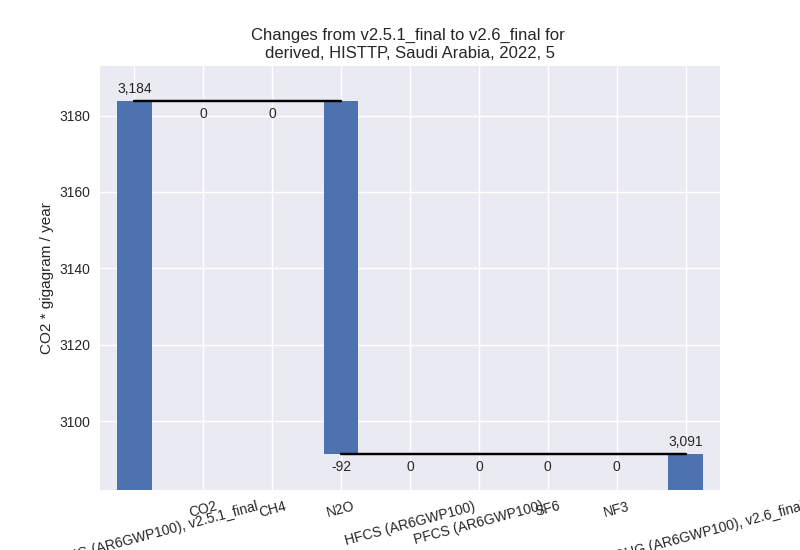Changes in PRIMAP-hist v2.6_final compared to v2.5.1_final for Saudi Arabia
2024-09-24
Johannes Gütschow
Change analysis for Saudi Arabia for PRIMAP-hist v2.6_final compared to v2.5.1_final
Overview over emissions by sector and gas
The following figures show the aggregate national total emissions excluding LULUCF AR6GWP100 for the country reported priority scenario. The dotted linesshow the v2.5.1_final data.
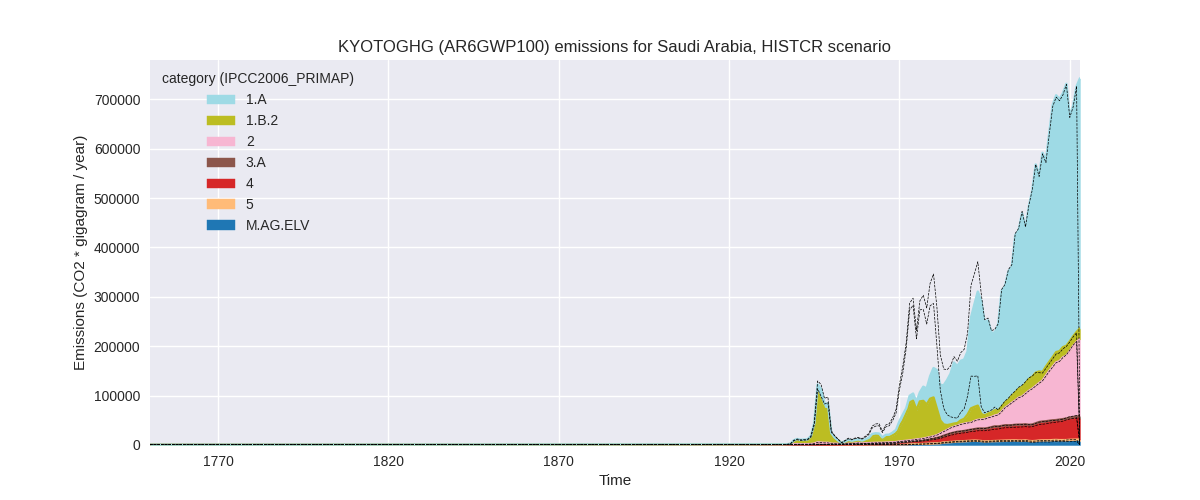
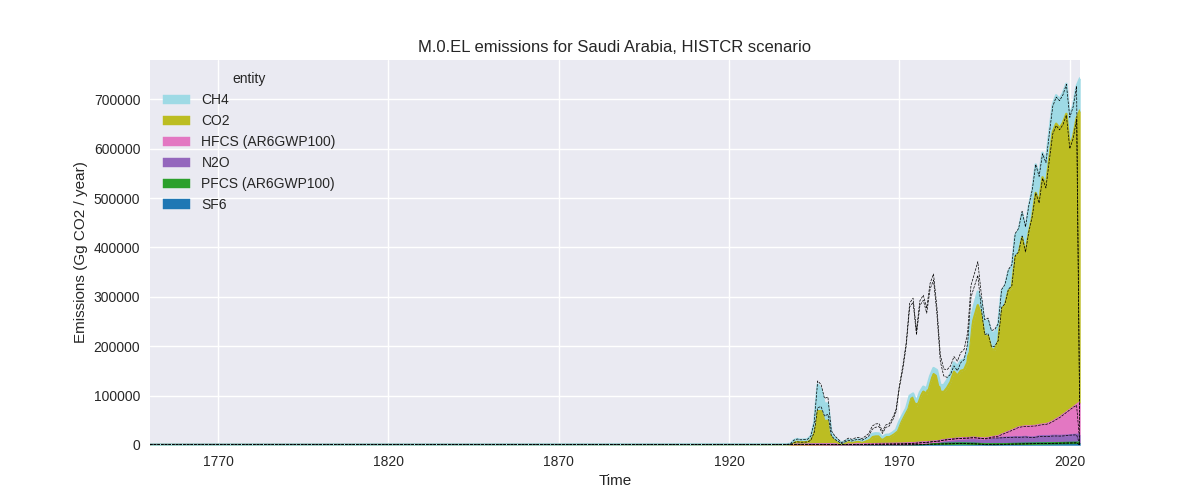
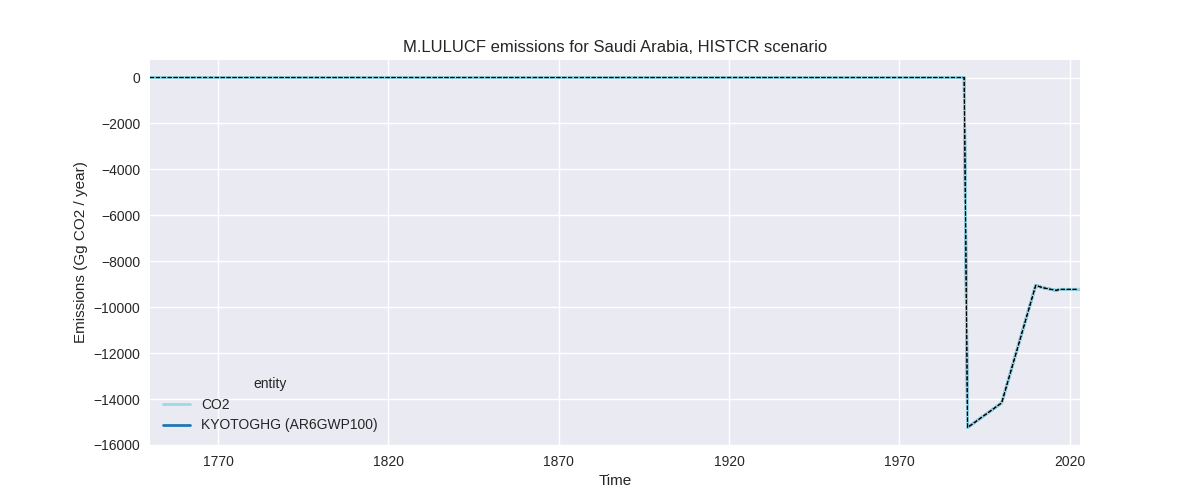
The following figures show the aggregate national total emissions excluding LULUCF AR6GWP100 for the third party priority scenario. The dotted linesshow the v2.5.1_final data.
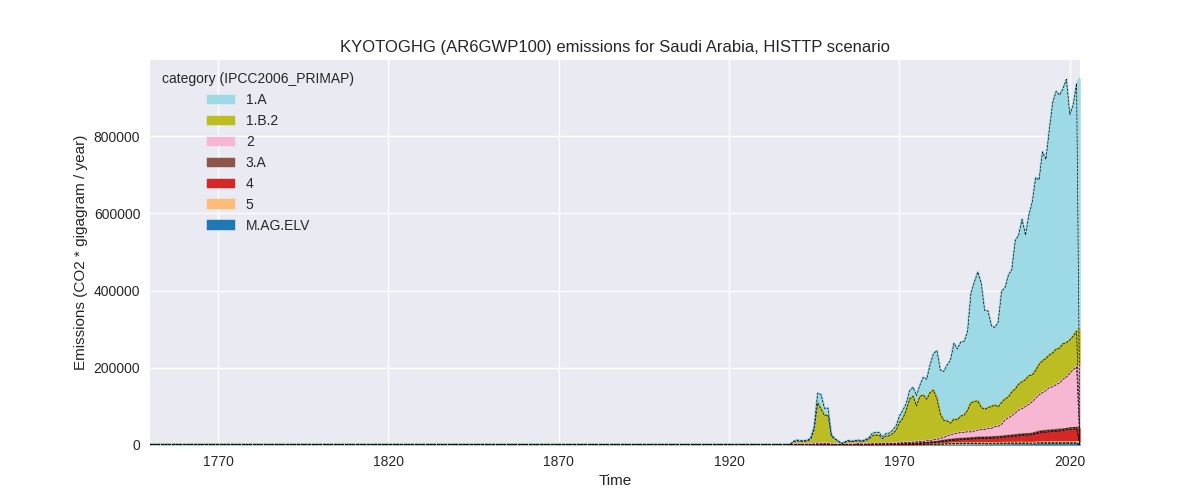
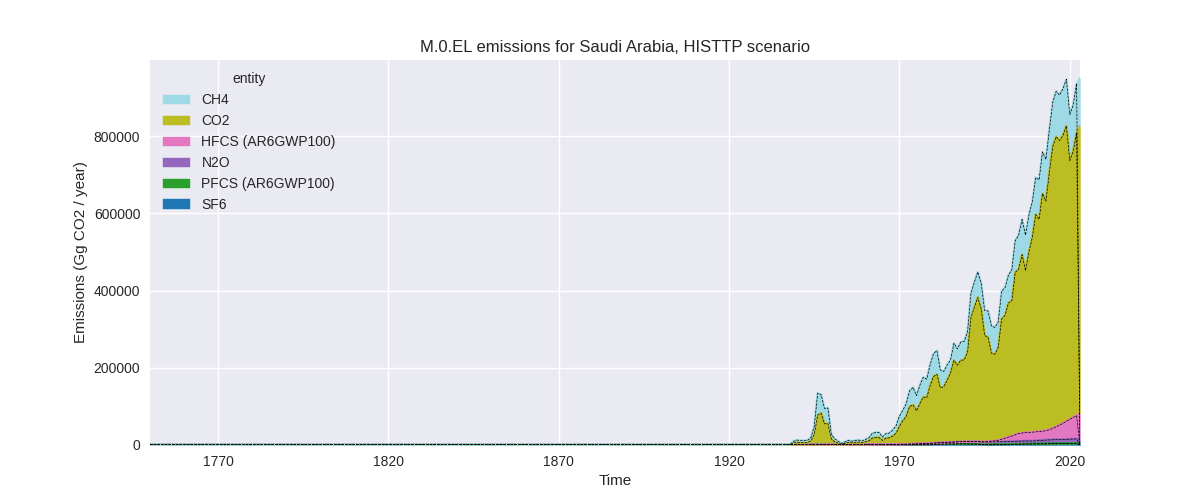
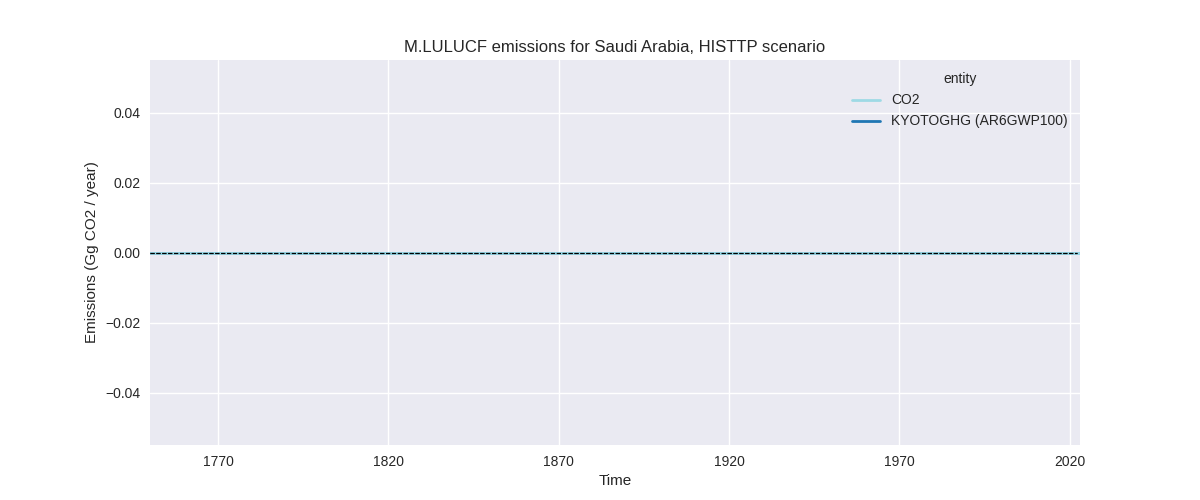
Overview over changes
In the country reported priority scenario we have the following changes for aggregate Kyoto GHG and national total emissions excluding LULUCF (M.0.EL):
- Emissions in 2022 have changed by 0.0%% (46.29 Gg CO2 / year)
- Emissions in 1990-2022 have changed by -1.7%% (-8059.56 Gg CO2 / year)
In the third party priority scenario we have the following changes for aggregate Kyoto GHG and national total emissions excluding LULUCF (M.0.EL):
- Emissions in 2022 have changed by -0.3%% (-2658.85 Gg CO2 / year)
- Emissions in 1990-2022 have changed by -0.0%% (-140.35 Gg CO2 / year)
Most important changes per scenario and time frame
In the country reported priority scenario the following sector-gas combinations have the highest absolute impact on national total KyotoGHG (AR6GWP100) emissions in 2022 (top 5):
- 1: 1.B.2, CO2 with 2653.28 Gg CO2 / year (106.6%)
- 2: 4, CH4 with -1926.80 Gg CO2 / year (-4.5%)
- 3: 1.A, CO2 with -1524.92 Gg CO2 / year (-0.3%)
- 4: 2, HFCS (AR6GWP100) with 875.93 Gg CO2 / year (1.5%)
- 5: 5, N2O with -92.35 Gg CO2 / year (-2.9%)
In the country reported priority scenario the following sector-gas combinations have the highest absolute impact on national total KyotoGHG (AR6GWP100) emissions in 1990-2022 (top 5):
- 1: 1.B.2, CO2 with -7933.62 Gg CO2 / year (-59.4%)
- 2: 4, CH4 with -188.99 Gg CO2 / year (-0.7%)
- 3: 5, N2O with -33.27 Gg CO2 / year (-1.5%)
- 4: 2, HFCS (AR6GWP100) with 26.54 Gg CO2 / year (0.1%)
- 5: 4, N2O with -13.41 Gg CO2 / year (-1.4%)
In the third party priority scenario the following sector-gas combinations have the highest absolute impact on national total KyotoGHG (AR6GWP100) emissions in 2022 (top 5):
- 1: 1.A, CO2 with -1965.06 Gg CO2 / year (-0.3%)
- 2: 4, CH4 with -1634.50 Gg CO2 / year (-4.8%)
- 3: 2, HFCS (AR6GWP100) with 875.93 Gg CO2 / year (1.5%)
- 4: 5, N2O with -92.35 Gg CO2 / year (-2.9%)
- 5: 1.B.2, CO2 with 42.60 Gg CO2 / year (0.8%)
In the third party priority scenario the following sector-gas combinations have the highest absolute impact on national total KyotoGHG (AR6GWP100) emissions in 1990-2022 (top 5):
- 1: 4, CH4 with -222.78 Gg CO2 / year (-1.1%)
- 2: 5, N2O with -33.27 Gg CO2 / year (-1.5%)
- 3: 2, HFCS (AR6GWP100) with 26.54 Gg CO2 / year (0.1%)
- 4: 1.B.2, CO2 with 9.08 Gg CO2 / year (0.2%)
- 5: 1.A, CO2 with -6.84 Gg CO2 / year (-0.0%)
Notes on data changes
Here we list notes explaining important emissions changes for the country. ’' means that the following text only applies to the TP time series, while means that it only applies to the CR scenario. Otherwise the note applies to both scenarios.
- No new country reported data for Saudi Arabia was included and overall changes are very small and come from updated energy CO2 data.
- We have fixed an extrapolation issue for 1.B.2, CO2 which lead to very high emissions between 1970 and 1980 by removing the country reported data which only covered a few years with very low emissions while the years with high emissions where not covered. This has also impacted emissions for recent years.
- Emissions in categories 4 and 5 have changed a little due to the removal of FAOSTAT data.
Changes by sector and gas
For each scenario and time frame the changes are displayed for all individual sectors and all individual gases. In the sector plot we use aggregate Kyoto GHGs in AR6GWP100. In the gas plot we usenational total emissions without LULUCF. ## country reported scenario
2022
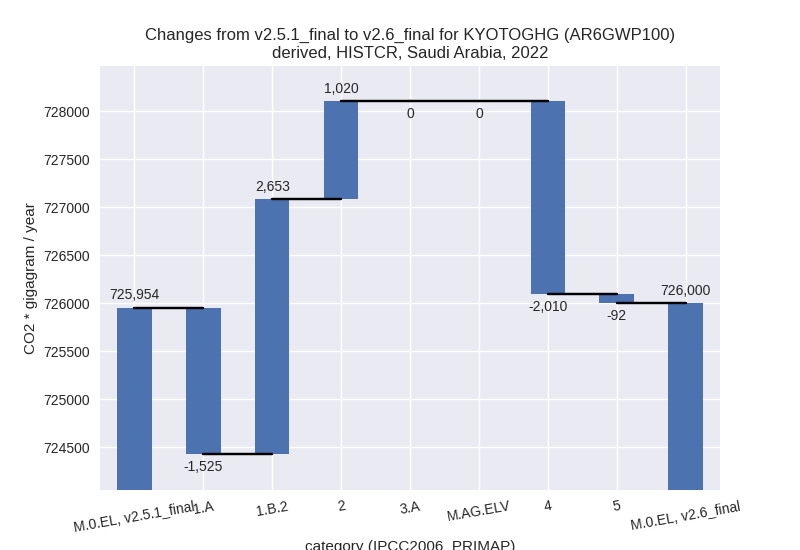
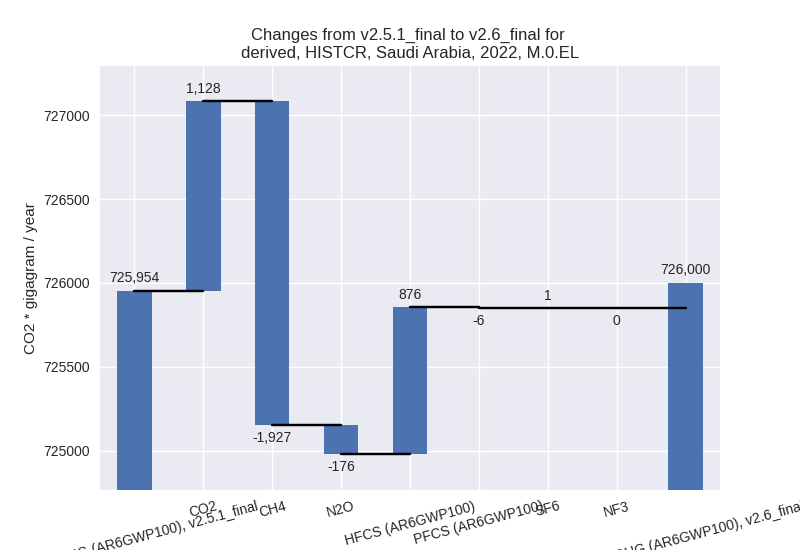
1990-2022
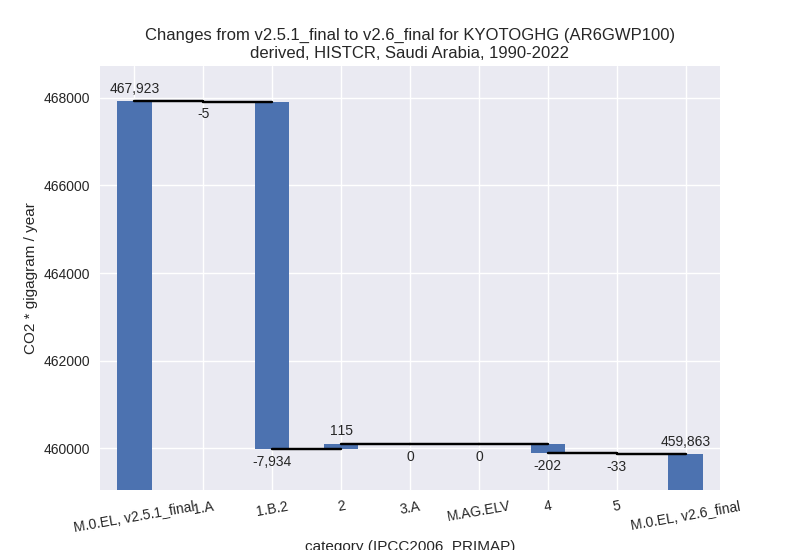
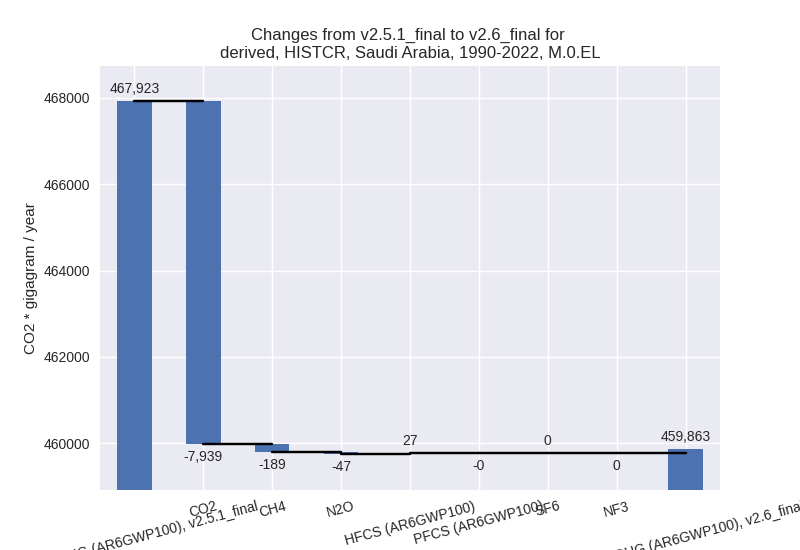
third party scenario
2022
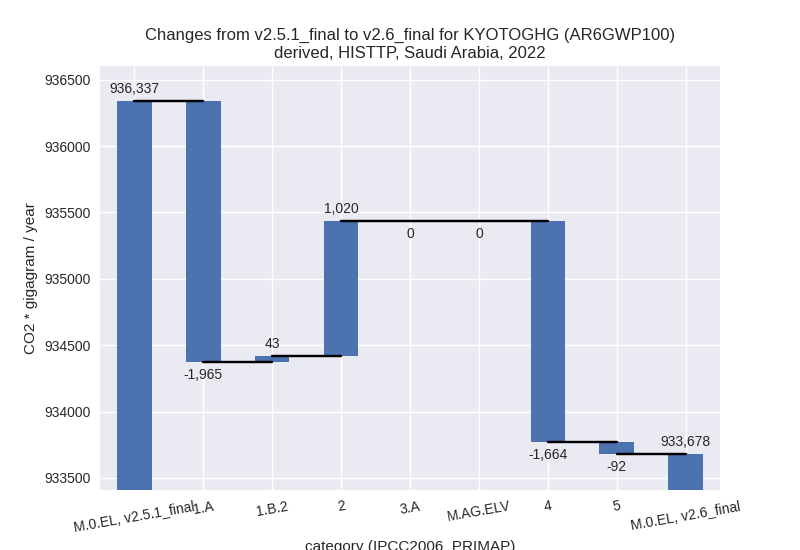
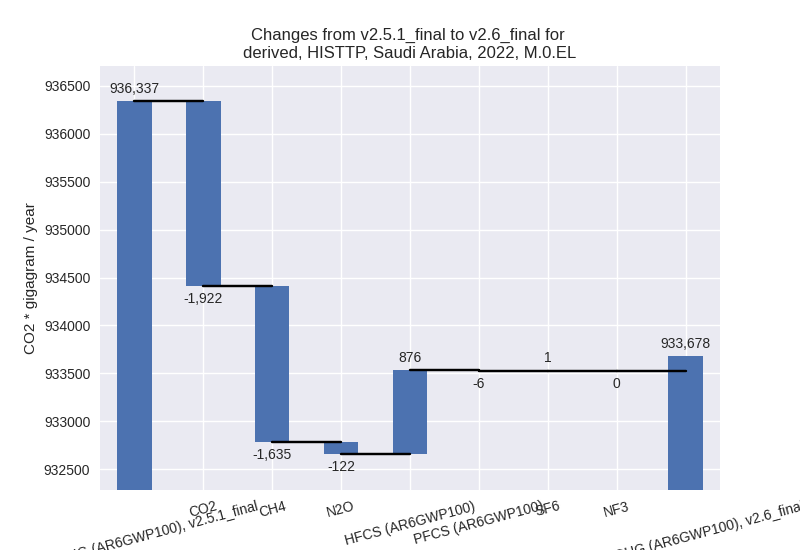
1990-2022
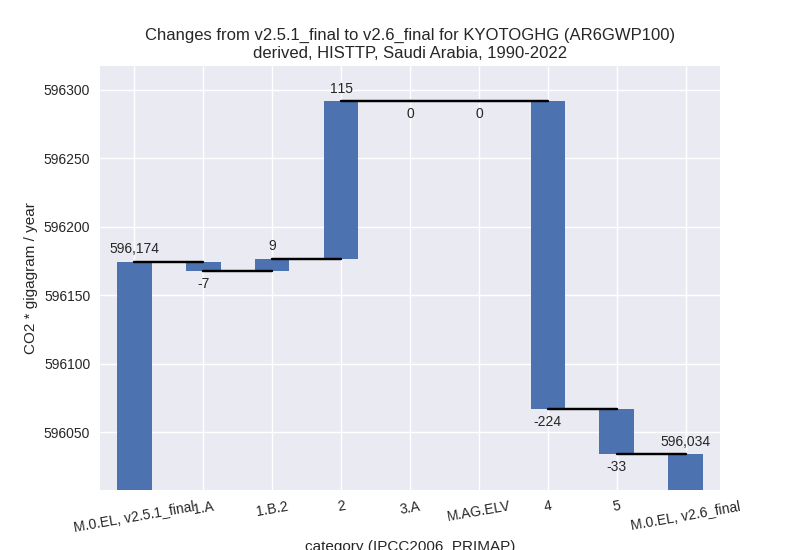
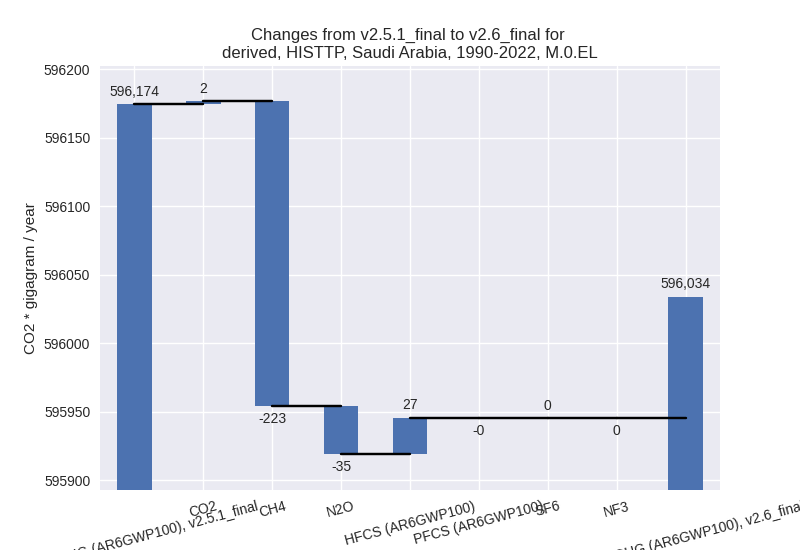
Detailed changes for the scenarios:
country reported scenario (HISTCR):
Most important changes per time frame
For 2022 the following sector-gas combinations have the highest absolute impact on national total KyotoGHG (AR6GWP100) emissions in 2022 (top 5):
- 1: 1.B.2, CO2 with 2653.28 Gg CO2 / year (106.6%)
- 2: 4, CH4 with -1926.80 Gg CO2 / year (-4.5%)
- 3: 1.A, CO2 with -1524.92 Gg CO2 / year (-0.3%)
- 4: 2, HFCS (AR6GWP100) with 875.93 Gg CO2 / year (1.5%)
- 5: 5, N2O with -92.35 Gg CO2 / year (-2.9%)
For 1990-2022 the following sector-gas combinations have the highest absolute impact on national total KyotoGHG (AR6GWP100) emissions in 1990-2022 (top 5):
- 1: 1.B.2, CO2 with -7933.62 Gg CO2 / year (-59.4%)
- 2: 4, CH4 with -188.99 Gg CO2 / year (-0.7%)
- 3: 5, N2O with -33.27 Gg CO2 / year (-1.5%)
- 4: 2, HFCS (AR6GWP100) with 26.54 Gg CO2 / year (0.1%)
- 5: 4, N2O with -13.41 Gg CO2 / year (-1.4%)
Changes in the main sectors for aggregate KyotoGHG (AR6GWP100) are
- 1: Total sectoral emissions in 2022 are 517664.54
Gg CO2 / year which is 71.3% of M.0.EL emissions. 2022 Emissions have
changed by 0.2% (1128.36 Gg CO2 /
year). 1990-2022 Emissions have changed by -2.2% (-7938.92 Gg CO2 / year). For
1990-2022 the changes per gas
are:
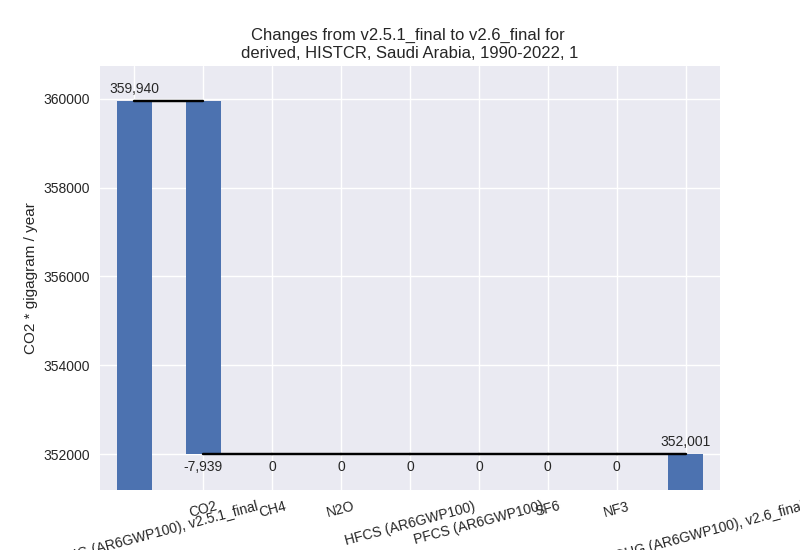
The changes come from the following subsectors:- 1.A: Total sectoral emissions in 2022 are 497315.58 Gg CO2 / year which is 96.1% of category 1 emissions. 2022 Emissions have changed by -0.3% (-1524.92 Gg CO2 / year). 1990-2022 Emissions have changed by -0.0% (-5.31 Gg CO2 / year).
- 1.B.2: Total sectoral emissions in 2022 are
20348.96 Gg CO2 / year which is 3.9% of category 1 emissions. 2022
Emissions have changed by 15.0%
(2653.28 Gg CO2 / year). 1990-2022 Emissions have changed by -30.6% (-7933.62 Gg CO2 / year). For 2022
the changes per gas
are:
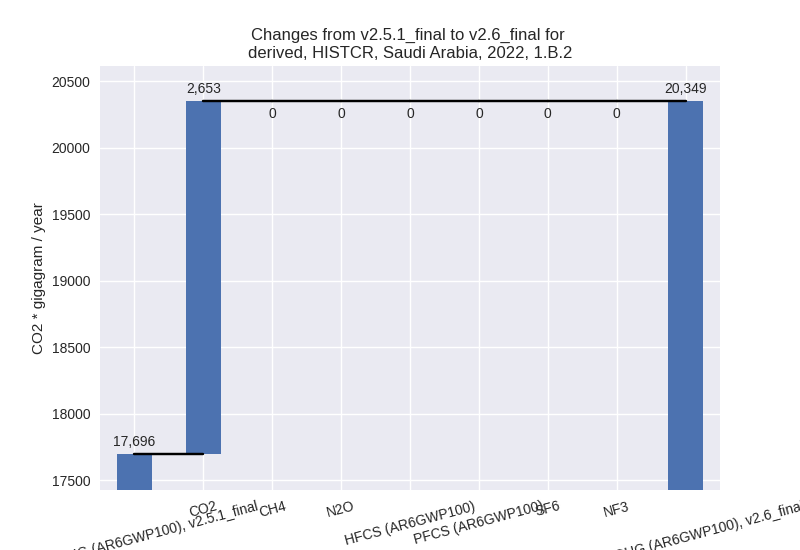
For 1990-2022 the changes per gas are: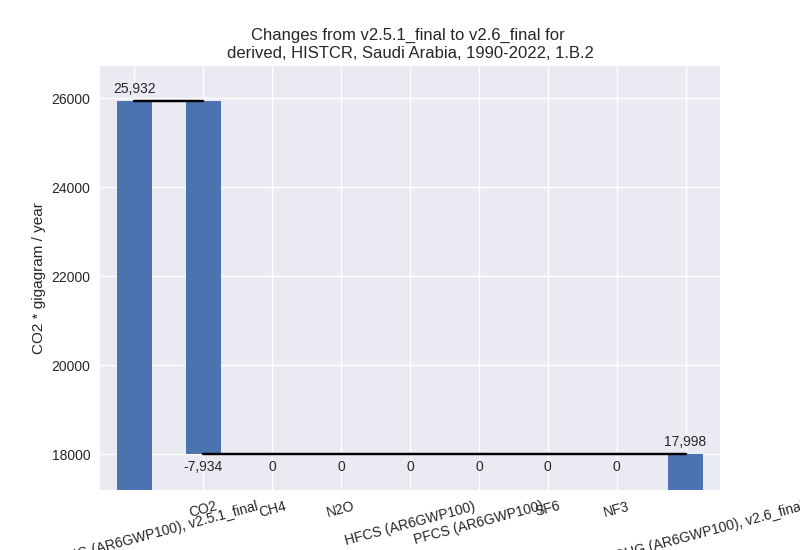
There is no subsector information available in PRIMAP-hist.
- 2: Total sectoral emissions in 2022 are 150915.94 Gg CO2 / year which is 20.8% of M.0.EL emissions. 2022 Emissions have changed by 0.7% (1020.45 Gg CO2 / year). 1990-2022 Emissions have changed by 0.2% (115.04 Gg CO2 / year).
- M.AG: Total sectoral emissions in 2022 are 12551.66 Gg CO2 / year which is 1.7% of M.0.EL emissions. 2022 Emissions have changed by 0.0% (0.00 Gg CO2 / year). 1990-2022 Emissions have changed by 0.0% (0.00 Gg CO2 / year).
- 4: Total sectoral emissions in 2022 are 41776.86 Gg
CO2 / year which is 5.8% of M.0.EL emissions. 2022 Emissions have
changed by -4.6% (-2010.17 Gg CO2 /
year). 1990-2022 Emissions have changed by -0.7% (-202.40 Gg CO2 / year). For 2022
the changes per gas
are:
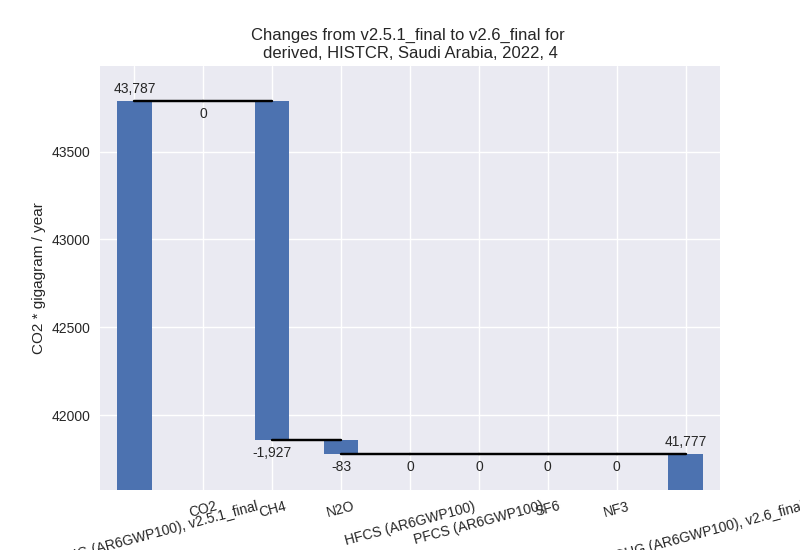
- 5: Total sectoral emissions in 2022 are 3091.38 Gg
CO2 / year which is 0.4% of M.0.EL emissions. 2022 Emissions have
changed by -2.9% (-92.35 Gg CO2 /
year). 1990-2022 Emissions have changed by -1.5% (-33.27 Gg CO2 / year). For 2022 the
changes per gas
are:
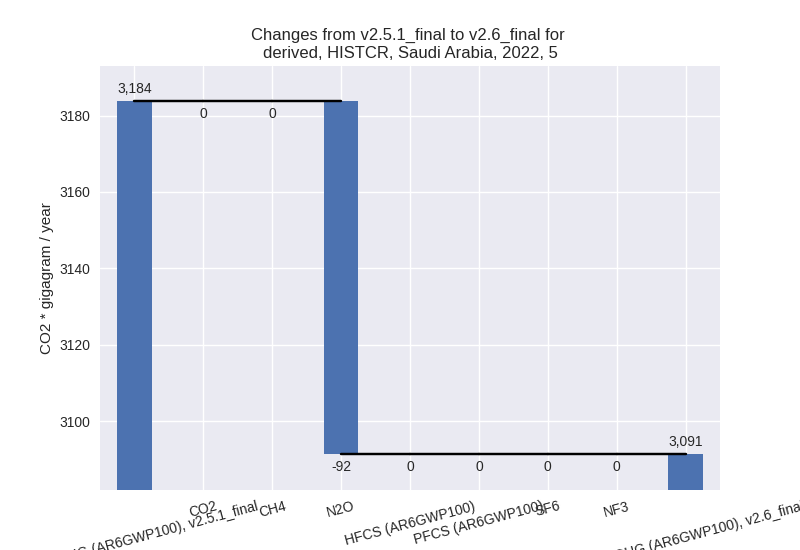
third party scenario (HISTTP):
Most important changes per time frame
For 2022 the following sector-gas combinations have the highest absolute impact on national total KyotoGHG (AR6GWP100) emissions in 2022 (top 5):
- 1: 1.A, CO2 with -1965.06 Gg CO2 / year (-0.3%)
- 2: 4, CH4 with -1634.50 Gg CO2 / year (-4.8%)
- 3: 2, HFCS (AR6GWP100) with 875.93 Gg CO2 / year (1.5%)
- 4: 5, N2O with -92.35 Gg CO2 / year (-2.9%)
- 5: 1.B.2, CO2 with 42.60 Gg CO2 / year (0.8%)
For 1990-2022 the following sector-gas combinations have the highest absolute impact on national total KyotoGHG (AR6GWP100) emissions in 1990-2022 (top 5):
- 1: 4, CH4 with -222.78 Gg CO2 / year (-1.1%)
- 2: 5, N2O with -33.27 Gg CO2 / year (-1.5%)
- 3: 2, HFCS (AR6GWP100) with 26.54 Gg CO2 / year (0.1%)
- 4: 1.B.2, CO2 with 9.08 Gg CO2 / year (0.2%)
- 5: 1.A, CO2 with -6.84 Gg CO2 / year (-0.0%)
Changes in the main sectors for aggregate KyotoGHG (AR6GWP100) are
- 1: Total sectoral emissions in 2022 are 732448.57 Gg CO2 / year which is 78.4% of M.0.EL emissions. 2022 Emissions have changed by -0.3% (-1922.46 Gg CO2 / year). 1990-2022 Emissions have changed by 0.0% (2.24 Gg CO2 / year).
- 2: Total sectoral emissions in 2022 are 157268.57 Gg CO2 / year which is 16.8% of M.0.EL emissions. 2022 Emissions have changed by 0.7% (1020.44 Gg CO2 / year). 1990-2022 Emissions have changed by 0.2% (115.04 Gg CO2 / year).
- M.AG: Total sectoral emissions in 2022 are 7917.59 Gg CO2 / year which is 0.8% of M.0.EL emissions. 2022 Emissions have changed by 0.0% (0.00 Gg CO2 / year). 1990-2022 Emissions have changed by 0.0% (0.00 Gg CO2 / year).
- 4: Total sectoral emissions in 2022 are 32952.38 Gg
CO2 / year which is 3.5% of M.0.EL emissions. 2022 Emissions have
changed by -4.8% (-1664.48 Gg CO2 /
year). 1990-2022 Emissions have changed by -1.1% (-224.35 Gg CO2 / year). For 2022
the changes per gas
are:
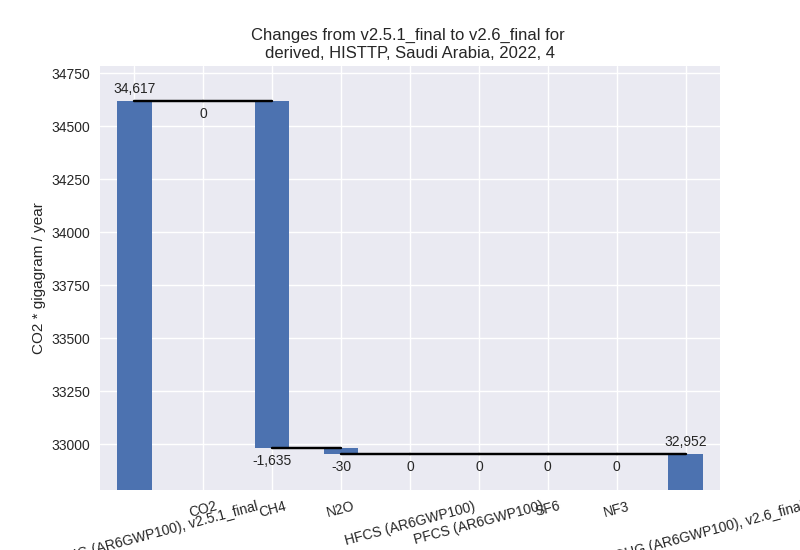
- 5: Total sectoral emissions in 2022 are 3091.38 Gg
CO2 / year which is 0.3% of M.0.EL emissions. 2022 Emissions have
changed by -2.9% (-92.35 Gg CO2 /
year). 1990-2022 Emissions have changed by -1.5% (-33.27 Gg CO2 / year). For 2022 the
changes per gas
are:
